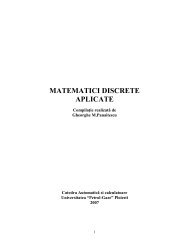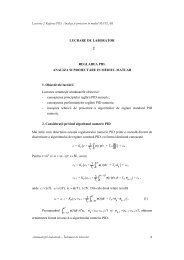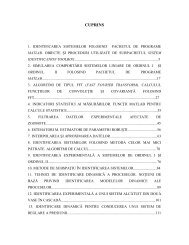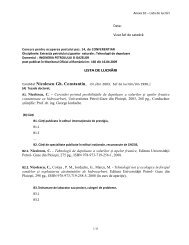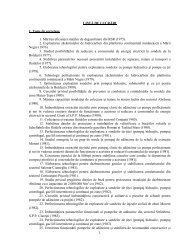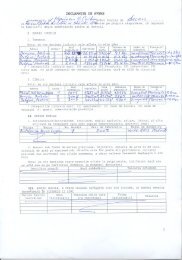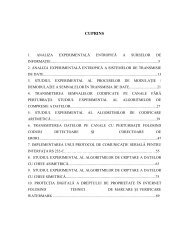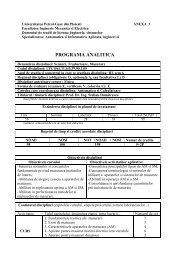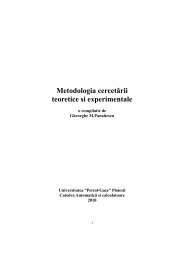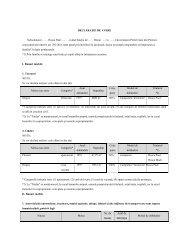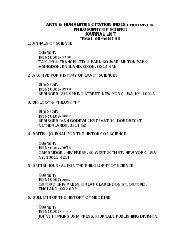Note de curs - Departamentul Automatica, Calculatoare si ...
Note de curs - Departamentul Automatica, Calculatoare si ...
Note de curs - Departamentul Automatica, Calculatoare si ...
You also want an ePaper? Increase the reach of your titles
YUMPU automatically turns print PDFs into web optimized ePapers that Google loves.
Mǎsurile aditionale pentru o retea cu trepte suplimetare<br />
A r <strong>si</strong> A m sunt numǎrul mediu <strong>de</strong> procesoare acce<strong>si</strong>bile, respectiv numǎrul mediu<br />
<strong>de</strong> memorii acce<strong>si</strong>bile.<br />
φ r (φ m ) sunt probabilitǎtile ca un procesor (o memorie) dat(ǎ) sǎ fie conectat(ǎ)<br />
la cel putin o memorie (un procesor).<br />
Pentru calcularea lui A r se face aceea<strong>si</strong> <strong>de</strong>scriere <strong>de</strong> stǎri: legǎtura este în starea<br />
X = 0 (X = 1) dacǎ toate (nu toate) cǎile <strong>de</strong> la procesor la memorii sunt <strong>de</strong>fecte.<br />
O cale <strong>de</strong>fectǎ este o cale care contine cel putin o legǎturǎ <strong>de</strong>fectǎ.<br />
O legǎturǎ <strong>de</strong>fectǎ este în starea X = 0.<br />
Numerotarea etajelor se mentine, k + 1 (procesoarele) la 0 (memoriile).<br />
Dacǎ X i <strong>de</strong>scrie starea legǎturii din etajul i<br />
φ r = p r p l Pr(X k+1 = 1)<br />
<strong>si</strong><br />
A r = N φ r<br />
Urmeazǎ calculul mǎsurii A r .<br />
Pr(X i = 1) se calcueazǎ re<strong>curs</strong>iv <strong>de</strong> la treapta 0 la treapta k + 1.<br />
X i , Y i noteazǎ <strong>si</strong> acum starea celor douǎ legǎturi din etajul i.<br />
Pentru etajul 0:<br />
Pr(X 0 = 1) = p m <strong>si</strong> Pr(X 0 = 0) = 1 – p m .<br />
Pentru etajul 1:<br />
Pr[(X 1 , Y 1 ) = (0, 0)] = {Pr[X 0 = 0]} 2 + 2Pr[X 0 = 0]Pr[X 0 3<br />
= 1]q l +<br />
+ {Pr[X 0 = 1]} 2 6<br />
q l<br />
Pr[(X 1 , Y 1 ) = (0, 1)] = Pr[X 0 = 0]Pr[X 0 = 1][q l (1 – q l2 ) + q l2 p l ] +<br />
+ {Pr[X 0 = 1]} 2 q l3 (1 – q l3 )<br />
Pr[(X 1 , Y 1 ) = (1, 0)] = Pr[(X 1 , Y 1 ) = (0, 1)]<br />
Pr[(X 1 , Y 1 ) = (1, 1)] = 2Pr[X 0 = 0]Pr[X 0 = 1]p l (1 – q l2 ) +<br />
+ {Pr[X 0 = 1]} 2 (1 – q l3 ) 2<br />
Pentru stǎrile 2, …, k, variabilele X i–1 , Y i–1 , Z i–1 , W i–1 exprimǎ starea celor patru<br />
legǎturi din etajul i – 1.<br />
Pr[(<br />
1,1,1,1<br />
i i<br />
i − 1 i−<br />
1<br />
X , Y ) = ( u,<br />
v)]<br />
= ∑ Pr[( X , Y ) = ( s0,<br />
s1)]<br />
.<br />
s0<br />
... s3<br />
= 0,0,0,0<br />
i − 1 i−<br />
1<br />
i<br />
i − 1 i − 1<br />
. Pr[( Z , W ) = ( s2,<br />
s3)].Pr[<br />
X = u | ( X , Z ) = ( s0,<br />
s2<br />
)] .<br />
i<br />
i − 1 i−<br />
1<br />
. Pr[ Y = v | ( Y , W ) = ( s1,<br />
s3)]<br />
Probabilitǎtile conditionate sunt:<br />
i<br />
i − 1 i − 1<br />
Pr[ X = 0 | ( X , Z ) = (0,0)] = 1<br />
Pr[<br />
Pr[<br />
Pr[<br />
Pentru etajul suplimentar k + 1:<br />
i<br />
i − 1 i − 1<br />
X = 0 | ( X , Z ) = (0,1)] =<br />
i<br />
i − 1 i − 1<br />
X = 0 | ( X , Z ) = (1,0)] =<br />
i<br />
i − 1 i − 1<br />
X = 0 | ( X , Z ) = (1,1)] =<br />
q<br />
q<br />
q<br />
l<br />
l<br />
2<br />
l<br />
97



